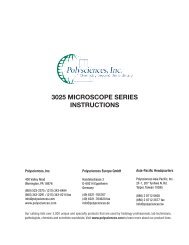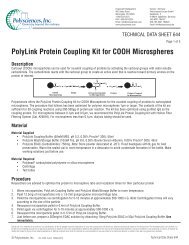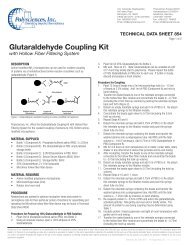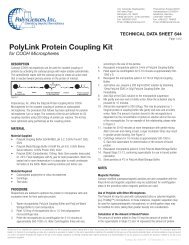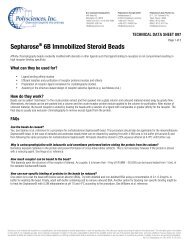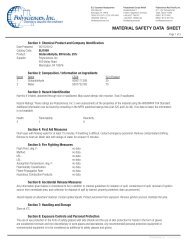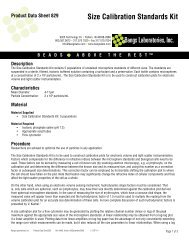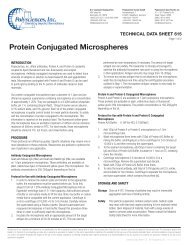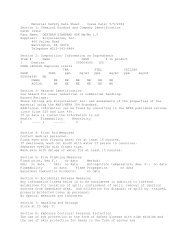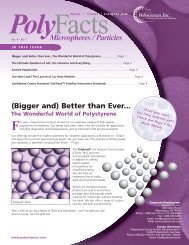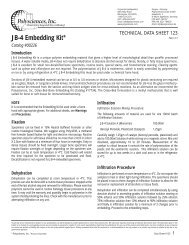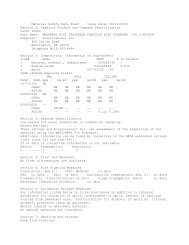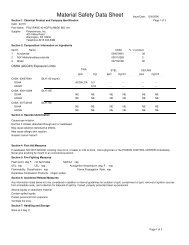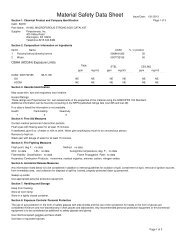BioSciences - Polysciences, Inc.
BioSciences - Polysciences, Inc.
BioSciences - Polysciences, Inc.
You also want an ePaper? Increase the reach of your titles
YUMPU automatically turns print PDFs into web optimized ePapers that Google loves.
Monomers<br />
New! 1-(Acryloyloxy)-3-(Methacryloyloxy)-2-Propanol [1709-71-3] . . . . . . . . . . . . . . . . . .<br />
MW 214 .22 n 20<br />
D 1 .473 200 ppm MEHQ d 1 .14 g/mL at 25º C<br />
Colorless to pale yellow viscous liquid<br />
Will increase the hydrophilic properties of polymers when copolymerized into<br />
a range of acrylate and methacrylate systems . This monomer has been used in<br />
antibacterial, liquid crystalline and phosphorous containing resins . The methacrylate<br />
and acrylate functionality provide increased reactivity relative to the<br />
dimethacrylate crosslinker .<br />
Duygu Avci and Lon J. Mathias, Polymer Bulletin, 2005, 54 (1-2), 11-19 Senhaji, O.; Monge, S.; Chougrani, K.; Robin, J. Macromolecular<br />
Chemistry and Physics, 2008, 209(16), 1694–1704. Dizman, B.; Elasri, M.O.; Mathias, L.J. Biomacromolecules, 2005, 6 (1), 514–520.<br />
Allyl glycidyl ether [106-92-3] EHO5g . . . . . . . . . . . . . . . . . . . . . . . . . . . . . . . . . . . . . . . . . . .<br />
MW 114 .1 bp 154° n 20<br />
D 1 .433 TSCA<br />
Reactive allyl ether . Can be used to introduce epoxide functionality into polymers<br />
made by free-radical polymerization .<br />
Allyl methacrylate [96-05-9] CH5g . . . . . . . . . . . . . . . . . . . . . . . . . . . . . . . . . . . . . . . . . . . . .<br />
MW 126 .2 bp 55º/30mm n 20<br />
D 1 .436 Requires Poison Pack 200 ppm MEHQ<br />
TSCA H 2 C=C(CH 3 )CO 2 CH 2 CH=CH 2<br />
Contains polymerizable units of differing reactivity, methacrylate moiety being<br />
more reactive than allyl .<br />
Allyl Phenyl Ether, 98% [1746-13-0] H4d . . . . . . . . . . . . . . . . . . . . . . . . . . . . . . . . . . . . . . . .<br />
MW 134 bp 185 n 20<br />
D 1 .52 Amber Liquid TSCA Specific gravity (20°C): 0 .97<br />
High purity monomer which has a high refractive index allowing it to be used as<br />
a synthon in modifying polymer refractive index properties .<br />
N-(2-Aminoethyl) methacrylamide hydrochloride U7d . . . . . . . . . . . . . . . . . . . . . . . . . . . .<br />
mp 121-123°C (polymerization is initiated around 122°C) (C 6 H 12 N 2 O)HCL<br />
White to off-white free flowing powder .<br />
Monomer building block for polymerization reactions which may yield<br />
a primary amine functional polymer .<br />
2-Aminoethyl methacrylate hydrochloride, min. 95% [2420-94-2] B6e . . . . . . . . . . . . . .<br />
MW 166 .6 mp 121-124º uninhibited TSCA<br />
O<br />
H C=C(CH )CO CH CH NH 2 3 2 2 2 2<br />
For preparation of polymers containing primary amine groups and preparation<br />
of specialty methacrylate monomers . Technical Data Sheet #522<br />
O<br />
NH • HCI 2<br />
N-(t-BOC-aminopropyl)methacrylamide [2197-397-94] U2bd . . . . . . . . . . . . . . . . . . . . . . .<br />
MW 242 mp 81-83°C uninhibited solid white powder C 12 H 22 O 3 N 2<br />
A solvent soluble, blocked primary amine monomer, it is soluble in a range of<br />
organic solvents and it polymerizes readily with other vinylic monomers . The<br />
t-BOC group is widely known to those in the peptide field and is easily deprot-<br />
ected to the free amine with a variety of reagents including HCl/MeOH, Me 3 Sil, or heat (185° C) .<br />
Copolymers containing N-(N-BOC-aminopropyl)methacrylamide can be readily converted to<br />
primary amino copolymers which can be further modified by coupling to peptides, dyes, etc .<br />
N-(3-Aminopropyl)methacrylamide hydrochloride, >98% [72607-53-5] U2bd . . . . . . . .<br />
MW 178 .7 mp 122-124º uninhibited TSCA (C 7 H 14 N 2 O)HCL<br />
Primary amine monomer . Hydrolytically stable for preparation of polymers<br />
containing primary amine functionality . Technical Data Sheet #522<br />
For use of N-(3-Aminopropyl)methacrylamide hydrochloride to make reductively biodegradable hydrogels<br />
for tissue engineering, see: Vetrik, M. et al, Polymer Degradation and Stability 96 (2011) 892-897<br />
O<br />
O<br />
H<br />
N<br />
O O<br />
OH<br />
N<br />
H<br />
O<br />
H<br />
N O<br />
O O<br />
O<br />
N<br />
H<br />
NH 2 • HCl<br />
NH 2 • HCI<br />
Catalog Size<br />
25351-50 50 ml<br />
25351-100 100 ml<br />
19191-50 50 g<br />
01643-500 500 g<br />
24894-100 100 g<br />
24833-5 5 g<br />
21002-10 10 g<br />
24318-10 10 g<br />
21200-5 5 g<br />
For more information please call (800) 523-2575 or visit: polysciences.com 129



